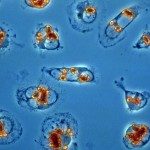Link to Pubmed [PMID] – 31846769
Link to DOI – S1874-3919(19)30389-610.1016/j.jprot.2019.103617
J Proteomics 2020 02; 213(): 103617
Leishmaniases are major vector-borne tropical diseases responsible for great human morbidity and mortality, caused by protozoan, trypanosomatid parasites of the genus Leishmania. In the mammalian host, parasites survive and multiply within mononuclear phagocytes, especially macrophages. However, the underlying mechanisms by which Leishmania spp. affect their host are not fully understood. Herein, proteomic alterations of primary, bone marrow-derived BALB/c macrophages are documented after 72 h of infection with Leishmania donovani insect-stage promastigotes, applying a SILAC-based, quantitative proteomics approach. The protocol was optimised by combining strong anion exchange and gel electrophoresis fractionation that displayed similar depth of analysis (combined total of 6189 mouse proteins). Our analyses revealed 86 differentially modulated proteins (35 showing increased and 51 decreased abundance) in response to Leishmania donovani infection. The proteomics results were validated by analysing the abundance of selected proteins. Intracellular Leishmania donovani infection led to changes in various host cell biological processes, including primary metabolism and catabolic process, with a significant enrichment in lysosomal organisation. Overall, our analysis establishes the first proteome of bona fide primary macrophages infected ex vivo with Leishmania donovani, revealing new mechanisms acting at the host/pathogen interface. SIGNIFICANCE: Little is known on proteome changes that occur in primary macrophages after Leishmania donovani infection. This study describes a SILAC-based quantitative proteomics approach to characterise changes of bone marrow-derived macrophages infected with L. donovani promastigotes for 72 h. With the application of SILAC and the use of SAX and GEL fractionation methods, we have tested new routes for proteome quantification of primary macrophages. The protocols developed here can be applicable to other diseases and pathologies. Moreover, this study sheds important new light on the “proteomic reprogramming” of infected macrophages in response to L. donovani promastigotes that affects primary metabolism, cellular catabolic processes, and lysosomal/vacuole organisation. Thus, our study reveals key molecules and processes that act at the host/pathogen interface that may inform on new immuno- or chemotherapeutic interventions to combat leishmaniasis.





